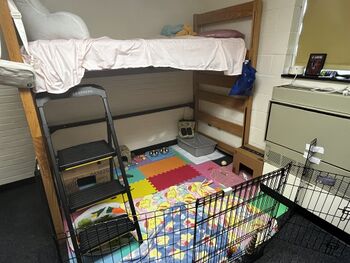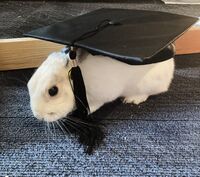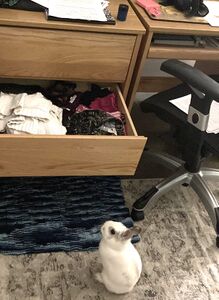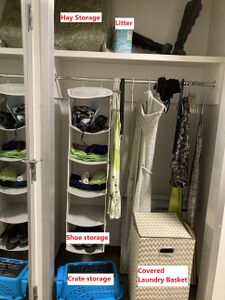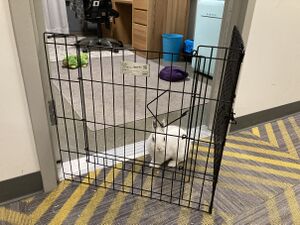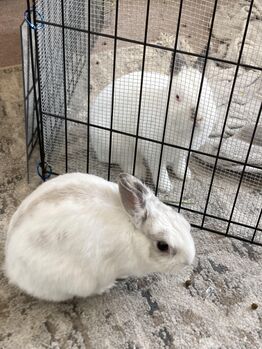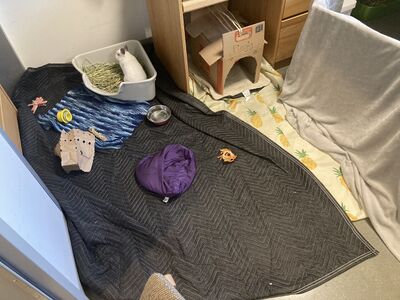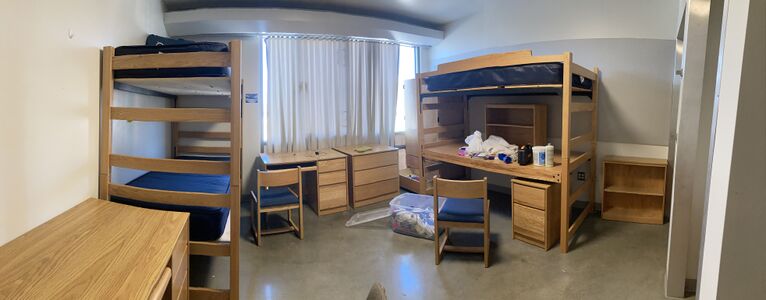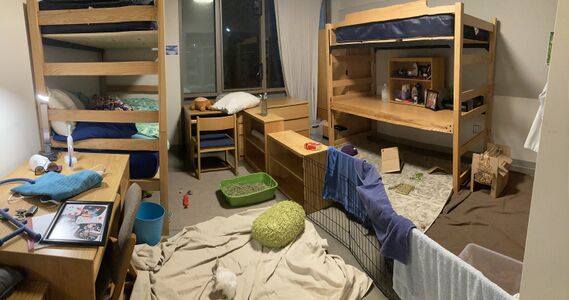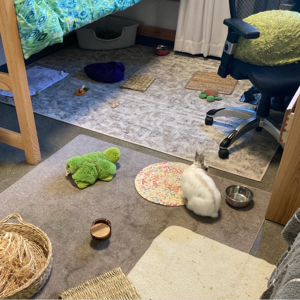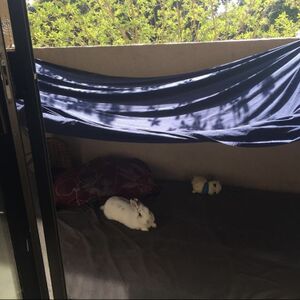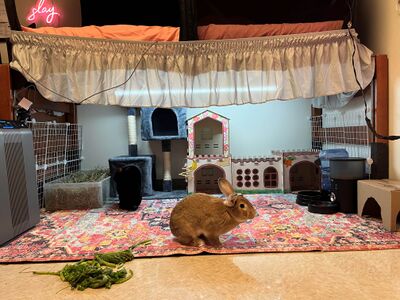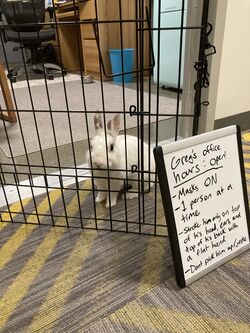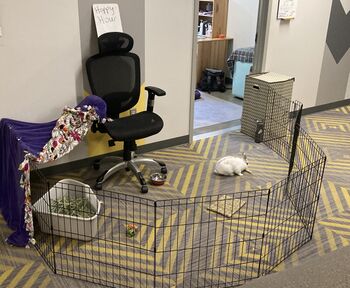Rabbits in college
Rabbits are abandoned at high rates the U.S., so it’s important to consider your rabbit’s future wisely when leaving for college. There are several options, but you should choose the scenario that provides the best care for your rabbit according to your personal circumstances. This article is geared for students attending colleges and universities in the United States.
In short, some college students can safely and responsibly bring their rabbit to college or become a new rabbit owner in college. However, your resources and school policies may make this impossible for your situation. You must do careful research on your own to verify the realities of pet ownership at your school and avoid lifestyles that are incompatible with rabbit ownership.
Are rabbits allowed in college?
Pet rules vary depending on your institution. It’s important to take early action so that you can try to accommodate your pet within school guidelines. Nominally, schools allow rabbits as “emotional support animals”, or ESAs. However, ESAs are a restricted status and you cannot declare a rabbit as an ESA without submitting valid paperwork to your institution for review. If you qualify for it, ESA status can be a good way to gain more autonomy over your rabbit’s protection. You should talk to your school about how ESA status impacts your room selection, and if you are entitled to a room that has favorable amenities to keep a rabbit comfortable (i.e., air conditioning, more space, no roommates, quiet dorm).
Many schools also allow rabbits without accommodations. You should ask current students if there are any rabbit owners on campus. If you can’t find a student pet owner, find a senior dean or administrator who is familiar with the school’s pet policy. The published pet policy may not actually be enforced, so a good administrator should be able to tell you how and when the policy applies to hopeful rabbit owners.
Even if rabbits aren’t allowed on-campus, students can usually choose to live off-campus in unaffiliated apartments or subleases nearby. These offer more flexibility with pet ownership and are usually cheaper, but require you to commute and live away from social events. You should browse Facebook groups for off-campus housing at your school. Also explore apartment listing websites for rabbit-friendly rentals.
You will travel at least four times a year with your rabbit (to/from winter break, to/from summer break) unless you have special exemption to stay on campus year-round. Research methods of traveling with a rabbit to choose an option that is safe and affordable for your situation.
For interstate travel within the U.S., review your destination's travel guidelines to see if you need special paperwork to bring a rabbit to the state where your college resides.
Can I have my rabbit secretly?
Do not attempt to have rabbits on-campus in secret if you are unfamiliar with the campus culture surrounding pets. You will be unprepared in the event of RA room inspections, fire drills, roommate allergies, student pranks, etc.
Even if you’re familiar with the campus pet policy, you should still consider disclosing your rabbit to relevant parties and try to reduce the negative impact of your rabbit on the community. Informing the administration or trusted student leadership can give you advanced notice about events that might jeopardize your rabbit’s welfare and plan accordingly. Get advanced notice of any room inspections, fire drills, or dorm pranks so you can move your rabbit to a safe location in advance.
College dorms can be highly unpredictable environments with unspoken cultural rules that may go against rabbit housing preferences. If you intend to keep a rabbit secretly, you forfeit any protection from the school when “harmless” campus culture rises to the level of animal abuse, such as harming or kidnapping your rabbit in a school prank ("Police warn college students after prank involving dead bunny", (RIP)). Transparent pet-friendly housing on campus makes it easier to find accommodations where your rabbit will be welcomed and respected by your neighbors.
A rabbit that is known to the community can be a rabbit that is beloved and supported by your peers, even featured on the campus newspaper. College students often miss their family pets when they leave for school, so an on-campus rabbit provides homesick students with a cute animal to spoil and coddle. Pets in college are frequently the recipients of homemade toys, hides, financial support, and offers to petsit for cheap. While you should be clear about your boundaries with unsolicited gifts or services for your rabbit, it is still a huge source of support that becomes more difficult to access if you keep your rabbit a secret.
Deciding to bring your rabbit to college
Owning a rabbit in college shares a lot of the same considerations as owning a rabbit anywhere else, but your options may be more limited since you are likely less financially secure and less secure in your housing options than the average rabbit owner. If you are considering becoming a first-time rabbit owner, please review the New Rabbit Owner Primer.
Young adults can find it challenging to provide a pet with a stable home environment when they themselves are experiencing an unstable life transition. Many worry that the life of a college student is too time-consuming to adequately provide daily attention and upkeep for a rabbit. This concern is well-founded, but does not hold up to scrutiny given that dogs, which require more daily maintenance time, are becoming increasingly popular college pets. Outside of class, college students can choose to work from home most of the time. This gives college students more flexible time to dedicate to pet care than someone working a full-time job.
Pet ownership can also be deeply integral to your adult identity. If you worry about your quality of life without pet ownership, then you should seriously consider if you can have a rabbit in college. Like any other college hobby, you can become more isolated or more social by having rabbits. But your finances will certainly be negatively impacted. Furthermore, many of your challenges will be unique to your own resources, circumstances, and school policies.
Location
Can you transport your rabbit to college? If you need to fly to your college town, see if there are any flights connecting your hometown and your college town on rabbit-friendly airlines. Few airlines allow rabbits in the cabin, so this may severely limit your options. It’s also expensive to fly with rabbits. Most students travel to/from their hometown twice a year for summer and winter break. Driving offers more flexibility and savings for travel accommodations but takes longer.
Your college town should have access to an exotic veterinarian, ideally 24-hour access via an emergency vet. If you do not have a driver’s license, your exotic veterinarian should be accessible by public transportation or you should account for the price of taxis or rideshares into your veterinary budget.
It’s also helpful to have a rabbit rescue within driving distance for hay, rabbit toys, boarding, grooming, and bonding services.
Finances
You should set aside a few hundred to a few thousand dollars of savings for rabbit healthcare each year, depending on the health of your rabbit and the cost of living in your college town. If you are able, talk to your parents about whether they would provide a safety net to cover your bills if you ever run out of money for veterinary expenses. You should also budget for hay, pellets, and rabbit enclosure supplies. If you plan to fly to/from college with your rabbits, factor pet travel expenses into your budget.
Picking up part-time, flexible-hour jobs around campus such as grading, tutoring, deliveries, or service desks can provide extra protection to replenish your emergency fund, even if you are a full-time student.
If you are already a student and planning to become a new owner, you will save money by adopting an adult, spayed/neutered rabbit from a rescue shelter. Spay/neuter is essential for your rabbit’s quality of life and good behavior, and costs several hundred dollars. Adopting a fixed rabbit offloads the cost of surgery onto the rescue. Thoroughly research before adopting a rabbit so you don’t waste money on unsuitable rabbit supplies like cages and improper food.
Lifestyle
A rabbit is a serious commitment that can take time away from your social and professional opportunities but may offer personal joy and fulfillment through animal care. Ask yourself if you want to be a rabbit owner, or if you merely want to have access to a cute rabbit. You can fulfill yourself with animal interaction by volunteering at a rescue shelter, becoming roommates with a pet owner, or working as a petsitter in your college town. This allows you to practice animal care without much financial or long-term commitment. If you do not already own a rabbit, you should explore these animal work opportunities before deciding whether a rabbit is right for you.
Certain lifestyles in college are incompatible with owning a rabbit. If you plan to do any of the following, you should reconsider having a rabbit in college:
- Study abroad
- Prank / party culture
- Frequent short-term travel (i.e., ski trips, camping trips, spring break trips, business conferences)
- On-campus housing with a strict no-pets policy
- Greek life
- Excessive drug use
Deciding not to bring your rabbit
If you have a rabbit and decide you are unable to bring them to college, then carefully consider your options.
If you are leaving your rabbit in the care of your parents, your parents should be enthusiastic participants in all aspects of your rabbit’s life, including healthcare, proper housing, social wellbeing, proper diet, and not leaving the rabbit unattended for more than 12 hours. Parents who do not have much rabbit experience should be enthusiastic to learn out of love for the rabbit, not merely out of promises to you. An unenthusiastic caregiver is a sloppy and unreliable one. Be aware that this is a huge responsibility to put on any indiviudal, not just your parents.
If your parents are not promising candidates, you should ask family and friends, then reach out to rescue shelter or foster home programs.
Off-Campus Housing
Off-campus housing is the most straightforward way to have a rabbit in college. This usually involves finding your own apartment or sublease and commuting to campus for class. Even if your school forbids rabbits on campus, you can usually find a pet-friendly housing option in the community.
You can start looking for leases on popular apartment listing websites, but make sure you ask around the student body to see if any apartments or leasing agents have a bad reputation in the area, or if some places are known to be pet-friendly. Schools may also have Facebook groups for enrolled students to find housing or roommates off-campus.
Living off-campus has considerable advantages:
- Is usually cheaper, but the opposite may be true in some situations
- Easier to find quiet, air-conditioned rooms
- More space than a dorm room, easier to free-roam
- More private; no RA room inspections, no party or prank culture
- Multiple rooms means the ability to set up neutral territory to bond additional rabbits
But also some drawbacks:
- Be prepared to commute. Ideally you have your own car in case of veterinary emergencies
- Isolated from campus life and social opportunities somewhat
- Cannot rely on school service departments for room repairs
- More independence means more responsibility to handle rent and utilities.
- Not pre-furnished
Try to negotiate a lease that lasts for the duration of the school year (i.e., not summer). Even if you think you’re staying on-campus over the summer, you don’t want to be locked into multiple leases if you need to move to another location for your summer job.
On-Campus Housing
At first, college dorms may seem like a daunting place to house rabbits. One-person dorm rooms are 100-150 square feet, whereas two-person rooms are 200-300 square feet. With careful planning, even the smallest rooms can comfortably accommodate a rabbit.
If your school allows rabbits on-campus through ESA status or the campus pet policy, you can absolutely have a rabbit in dorm rooms. You just need to be careful with selecting your room, bunny-proofing your room, following safety precautions, and reserving enough space for your rabbit to live comfortably.
On-campus housing has its own advantages:
- Access to school maintenance staff to fix broken air conditioning, plumbing, etc
- Proximity to laundry machines
- Proximity to social events and professional development
- Water and utilities pre-paid
- Easy to enlist trusted friends to petsit during short-term travel
- Somewhat pre-furnished for easy move-in and bunny-proofing
- Easy to make friends with animal-lovers on campus
But also drawbacks:
- Often unairconditioned
- Usually more expensive
- Smaller living accommodations
- Roommates often required for some or all years (unless you have disability accomodations)
- Competitive room selection process. Pet-friendly rooms in short supply
- Fire drills
- Possibly RA room inspections
- Student parties and pranks
- No neutral territory to bond additional rabbits
- Proximity to drug use
Competing for good dorms
Your college will have a number of different dorms, with different amenities, policies, and student cultures attached. Even if your school allows rabbits, it may only be practical or allowed for a small selection of dorms or floors. Dorm selection is also very competitive since there is rarely enough housing for everyone that needs it. If you can’t live off-campus, you need to fight for advantages that ensure you and your bunny will have a place to live.
If your rabbit is an ESA, you should be able to apply for a room through the disability & accommodations office. This may involve pre-placing you into a room that fits your description. Review the list of favorable vs. unfavorable dorm traits when communicating with the accommodations office.
Make friends with an RA or dorm president. RAs are guaranteed housing in better-than-average rooms, so they are good candidates to be bunny roommates. At some schools, upperclassmen also get seniority with housing selection and also make good roommates as a result.
Find your roommates early. Don’t wait until Spring to start learning about the room selection process. Strategies to survive room draw are often not public knowledge, but spread by word-of-mouth. Schools may also have Facebook groups for enrolled students to find housing or roommates on campus. Bunny-friendly rooms are often for most competitive and coveted, so you should become an expert in the room selection process to give yourself the best chance for success.
Favorable dorm traits:
- Good air conditioning
- Allows pets / not allergy-restricted
- Single rooms
- Quiet dorm culture (i.e., not fraternities, sororities, or party dorms)
- Windows that don’t get direct sunlight (can overheat rooms)
- Outdoor trash bins (to dump out dirty litterboxes)
- Non-smoking floor (central air conditioning may move smoky air between rooms)
- Communal kitchens to refrigerate rabbit vegetables
- Close street access for easy vet travel
Unfavorable dorm traits:
- No air conditioning
- Doubles or triples (see: roommates)
- Party dorm or greek life
- Lax drug policy
- Allergy-restricted
- Room opens to courtyard, motel-style (worse noise insulation, rabbit escapes are more risky)
Bunny-Proofing a Dorm
Furniture often comes with the room, and you may even be required to keep it in the room even if you don’t want it. Avoid bringing any of your own furniture to college unless you’re absolutely sure you need it or use it for rabbit-proofing.
Bunny-smart furnishings include:
- Hanger hook shelves for elevated storage
- Lidded laundry hamper to store dirty clothes securely
- Plastic storage drawers that can fit on top of your dresser
- Wall decorations out of reach of rabbits
- Cheap, decorative blankets for the floor that are OK for your rabbit to dig/chew at
- Cardboard boxes to turn into hides or toys
- Cord protectors
- Lidded trash can
- Elevated shoe storage
- Command hooks to hang backpacks, umbrellas, coats
- Xpen corner to store your bike or scooter (bunnies chew the wheels)
- Secure food storage
- Your own vacuum, broom, or dustpan (communal cleaning supplies are usually unavailable or hard to reserve).
- Simple cardboard box hides that collapse or recycle easily
- Hay storage container
Try to avoid:
- Beanbags, which rabbits will pee on
- Rabbit-toxic houseplants
- Air fresheners or scented misters
- Low surfaces. Short chairs/sidetables/storage bins can act as stair steps for bunnies to reach high surfaces where they are unsafe. Keep chairs tucked under desks when not in use and stack low bins on top of each other to make the top surface too high for a rabbit to access.
- Uncovered floor storage
- Exposed wires
Safety Precautions
- Many worry about excessive noise when owning a rabbit in college. In reality, unless you’re planning to live a partygoer lifestyle, noise is not a huge fact of life for most college students anymoreso than living in a regular apartment complex. At most schools, frequent partygoers make up a minority of the student body. Busy students can be just as intolerant of residential noise as your average rabbit, so there are almost always places to live on-campus that cater to a quiet lifestyle. You should actively seek these out during room selection. If your only choice is to live in a noisy party dorm, you should seek off-campus housing options. Main article: Fireworks.
- Keep 2-3 panels of xpen outside your front door to block your rabbit from escaping.
- Talk to your school administrators about advanced notice of all residential fire drills. Bring your rabbit to your car before the fire drill starts and stay with them until it's over.
- Never bring your rabbit outside on a leash or free-roaming in an outdoor pen. College campuses are popular locations to walk dogs, some of which may be off-leash. Rabbits on leashes or in pens cannot be protected from predation if an off-leash dog catches sight of your rabbit. Main article: Walking a rabbit.
- Do not bring your rabbit to class or the library with you. This endangers students with allergies and puts your rabbit at risk for GI stasis or other stress-related health complications. Any socialization with other students should happen inside residential halls.
- If you or your roommate are bringing new visitors inside, always be present to supervise your rabbit’s reaction. Strangers may try to grab or hold a rabbit, which is dangerous. Only allow guests unsupervised if you trust that they are fully informed about boundaries with your rabbit. If your rabbit is especially scared of strangers, you should discuss with your roommate about limiting guests in the room.
- Your room may get maintenance or inspections when you are not home. Talk to your RA about rabbit safety and personal boundaries after you move in. If you file a request for room maintenance with your school’s facilities & maintenance department, you should tell them to call you before they service your room. Give them a list of times when you’re available to supervise so you can move your rabbits out of the room if necessary.
- If your school has a no-prank list to opt-out of school pranks, add your room to the list. Prank culture often involves entering and altering a student’s room, which is not safe for a rabbit.
- Do not host parties or drinking events in your room. For events in your suite or hallway, try to keep noise to a minimum and call campus security if a student is trying to enter your room uninvited or making more noise than is allowed under campus policy.
- Always keep your door locked when you are not home. If you are on the ground floor, keep your window closed at night or when you are absent. While incidents are usually rare, college dorm rooms are seen as easy targets for burglars.
- Since dorm rooms are small, the temperature can change rapidly inside with poor insulation or direct sunlight. Temperatures above 85°F (29°C) can easily cause heat stroke in rabbits. Make sure you get airflow from air conditioning on hot days. If AC is inadequate, you may need to prop your door open to get cool air from the lounge or hallway outside (with an xpen blocking your rabbit from escaping). Main article: Hot weather concerns.
Cages/Hutches/Small Pens
Small enclosures like cages, hutches, and small pens are *not recommended* for housing a rabbit in a dorm room. Rabbits need at least 16 square feet as a “rest area” (i.e., cage, pen, hutch) when combined with at least 4 hours of exercise time in a larger space (i.e., the rest of your room).
If the exercise area is safe enough to leave your rabbit unsupervised, then convert the exercise area to their full-time living space and ditch the cage! If you don't already have a cage, don't buy one!
Roommates may expect a caged rabbit, so be clear about your plan to give your rabbit more space. Show them pictures of appropriate setups instead and discuss each other’s boundaries with pet accommodations.
Large Pens
A rabbit needs at least 24 square feet for a full-time living enclosure. A large xpen is a good compromise if you can’t bunny-proof the entire dorm room. There are some strategies to make this easy to implement:
- Loft your bed so that your rabbit can roam underneath. 3 feet of height clearance between the floor and bottom of the bed allows enough room for all rabbit amenities and easy access for cleaning. Most college beds have lofting capability built-in, but you should call Facilities & Maintenance to do it for you. College beds are size Twin XL, which has a 21 square foot footprint. An xpen wrapped around your bed nearly meets the minimum size for a full-time rabbit enclosure.
- Utilize storage alcoves. Closets and under-the-desk space don’t take up walking space. If you don’t use these nooks for your own storage, consider converting them to private spaces for your rabbit’s litterbox or hide. This maximizes walking space for you. Built-in overhead shelves are good places to store the hay, litter, and pet carriers.
- For unbonded rabbits: if you are creating two separate pens for unbonded rabbits, line a single layer of xpen with hardware cloth (attach with wires or zipties). The metal mesh is strong and bite-proof, making it unnecessary to set up two layers of xpen with a buffer zone in-between.
- Provide adequate flooring. Protect existing carpeting with your own rugs or blankets, and cover up smooth surfaces that can damage your rabbit’s feet
There are still some downsides to using an xpen setup. Xpens make the room feel smaller by allocating some spaces not for human use. Xpens are also bulky to transport, taking up a lot of room in a car and needing to go in checked luggage for a flight. When you leave college over the summer, you need to take the pen panels with you or purchase long-term storage.
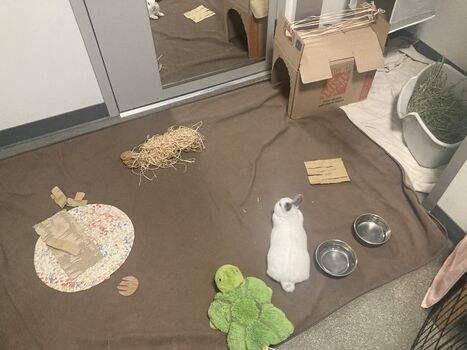
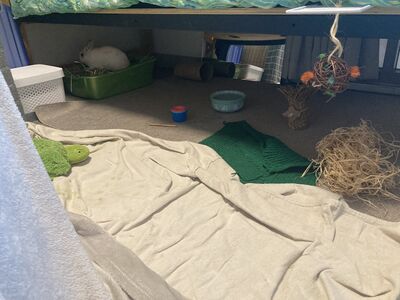
Free-Roaming
Free-roaming is one of the best ways to maximize comfort for you and your rabbit. However, this may take careful planning and bunny-proofing to achieve:
- Ask your roommate(s) if they feel comfortable bunny-proofing their setup. You should show them where to get cord protectors and storage options that make their belongings inaccessible to a rabbit. If your roommate(s) do not feel comfortable with this, then you should talk to them about an xpen setup instead.
- Set up 2 panels of xpen outside your front door to prevent escapes
- Keep litterboxes and hides tucked away in alcoves under your desk, under your bed, or under your clotheshangers.
- Loft your bed to prevent your rabbit from peeing there. Most college beds have lofting capability built-in, but you should call * Facilities & Maintenance to do it for you.
- Store hay, litter, and pellets in overhead shelves or inside storage containers (their hard travel carriers can double as storage!)
- Keep clothes off the floor, keep school supplies on your desk
- Buy cord protectors for your wires if the power outlets are within reach of rabbits
- Buy cheap rugs or blankets to protect built-in carpet from chew damage and cover up smooth surfaces that are harmful to rabbit feet. Try to choose options that are machine-washable in case you don’t have time to vacuum.
- Be careful with balconies. Make sure there is not a gap for your rabbit to escape from a balcony and that the weather is mild. Your rabbit should always have a clear path to run back inside if you allow balcony access. Rabbits have poor depth perception and can easily fall from a balcony if their curiosity strikes.
Communal Spaces, Meet-and-Greets
Rabbits should not be housed in communal areas such as living rooms, hallways, dorm bathrooms, dorm kitchens, or courtyards. Even if you are only sharing these spaces with a few people, it is irresponsible to enforce standards of rabbit care in shared spaces when you are not present. Your suitemates and neighbors are not petsitters. Rabbits also get in the way of normal use of communal spaces, so meet-and-greets with neighbors should be unobtrusive or special occasions only. Main article: Walking a rabbit
There may be times when your rabbit can visit communal spaces for voluntary socialization. College campuses are popular for off-leash dogwalking, so social events with your rabbit should always be done indoors. If your roommates agree, you can set up regular “office hours” for fellow students to visit your rabbit while you supervise. This is a great way to make friends through your rabbit in college. If your door connects to an indoor area, you can even leave your door open while you’re home and secure the xpen at the entrance so your rabbit can beg for attention from your neighbors. You should always supervise these interactions carefully and get to know your neighbors before attempting.
If your door opens to a communal space, such as a suite, consider talking to your neighbors and/or RA about having dedicated exercise time in the common area for people to meet your rabbit. Make sure your rabbit has access to your room at all times if they get overwhelmed or want to use the litterbox.
Roommates
As much as possible, you should plan on being the sole caregiver for your rabbit. Shared responsibility between roommates can erode roommate relationships. You and your roommate should also thoroughly discuss what to expect from living with rabbits before you decide to room together. When talking to prospective roommates, ask people to be honest and forthcoming with their boundaries. It can be difficult or impossible to switch roommates after housing arrangements are finalized, so you need to choose people wisely. Inadequate communication of boundaries creates dysfunctional living situations that put your rabbit in harm’s way.
It also helps to share some pictures and videos of your rabbit in its current setup, interacting with people. Your roommate is taking on a lot of risk by agreeing to live with an animal, especially if they’re unable to meet your rabbit before you move in together. Pictures of your rabbit both endear your roommate to the idea of living with a rabbit, and educate about what life with a rabbit might look like. You can also refer them to the New Rabbit Owner Primer if they’re interested to go in-depth.
Sample questions to add to your roommate questionnaire:
- Do you have allergies to grass or animals? Grass allergies can translate to hay allergies, which would be a poor fit. Cat or dog allergies are not necessarily synonymous with rabbit fur allergies, but it’s still a risk.
- Do you like rabbits? Your roommate should not be afraid of your rabbit or apathetic to its wellbeing
- Have you ever owned a rabbit? If so, what was its life like? People who have owned rabbits before have their own assumptions about how a rabbit should be treated. Listen carefully to their description of rabbit ownership and inform them about ways in which your standards of care will be different from theirs. It’s OK if people have no prior rabbit experience, as long as they’re open-minded to the idea of sharing space with one.
- My rabbit will be housed like ___. To protect my belongings, I bunny-proof like ___. Would you be open to my feedback when you’re setting up your side of the room so I can help you bunny-proof your belongings? Offer help, but do not alter people’s belongings uninvited. For roommates who can’t manage to bunny-proof, you may have to restrict your rabbit from the roommate’s side of the room.
- My rabbit is/isn’t litterbox trained. This is how I clean up, that has worked for me to keep my space hygienic. Do you have any questions about the cleanliness of this process? Allow them to express any hygiene concerns, think of ways to make them comfortable
- How do you feel about hay or fur getting onto your belongings? We will be in close proximity, and these can easily get out of my rabbit’s area despite my best efforts.It’s good to acknowledge areas in which your routine is imperfect. Hay and fur will impact your roommate inevitably. If they * can’t tolerate that, they might not be a good fit.
- Rabbits are very fragile creatures. Would it be okay if I’m present at first when new people come over so I can tell them about house rules with rabbit handling and safety?
- Do you use recreational drugs? Do you smoke? Can you keep reckless intoxication and drug vapors away from my rabbit?
- Do you want to have parties near or in our room? Would you be okay living in a “quiet dorm”? Quiet social gatherings are to be expected sometimes, but loud and crowded events should not occur in or near the room.
- Here’s what I do to keep my room smelling clean. Do you think you can live like this, i.e., without chemical air fresheners or strong perfumes?
- When I’m out of town for short trips, can I hire someone to visit our room to take care of feeding and cleaning up after my rabbit?
- I take good care of my rabbit’s health, so you wouldn’t have to do anything. (Include additional details: they’re up-to-date on their vaccinations, spayed/neutered, have no history of aggression, are very social, bonded pair, well-trained, etc). There’s a lot of negative stereotypes surrounding college pet owners. Someone may be hesitant to room with you because they worry you are a neglectful or irresponsible pet owner simply by bringing an animal to college. Demonstrate that you know your rabbits and you’re up-to-date on the best practices for rabbit care.
- Lots of people may want to come visit our room to meet my rabbit(s) during the school day. How do you feel about this? How many people at a time? How much prior notice do you need?
- If my rabbit decides they don’t like visitors, could we limit the number of guests that visit our room?


